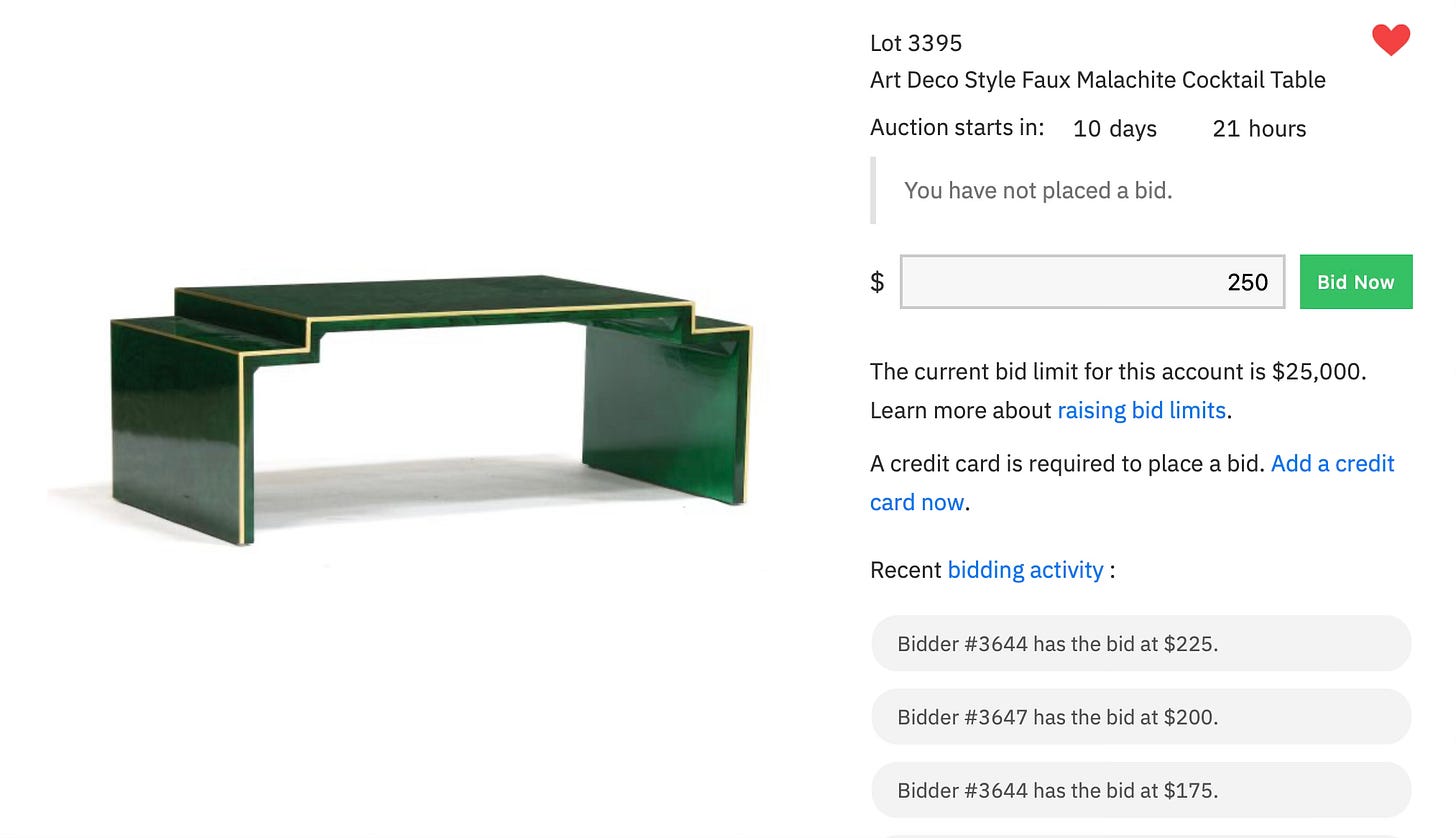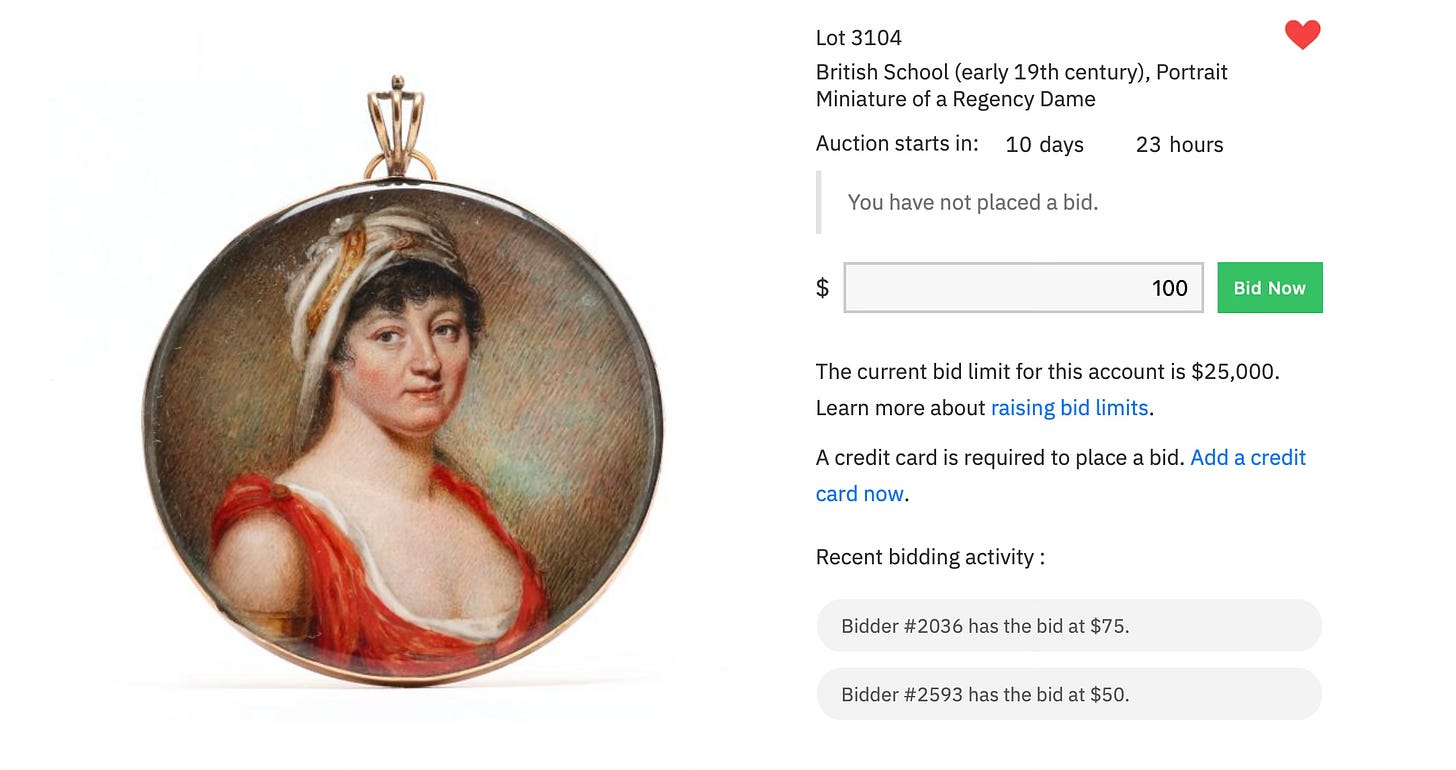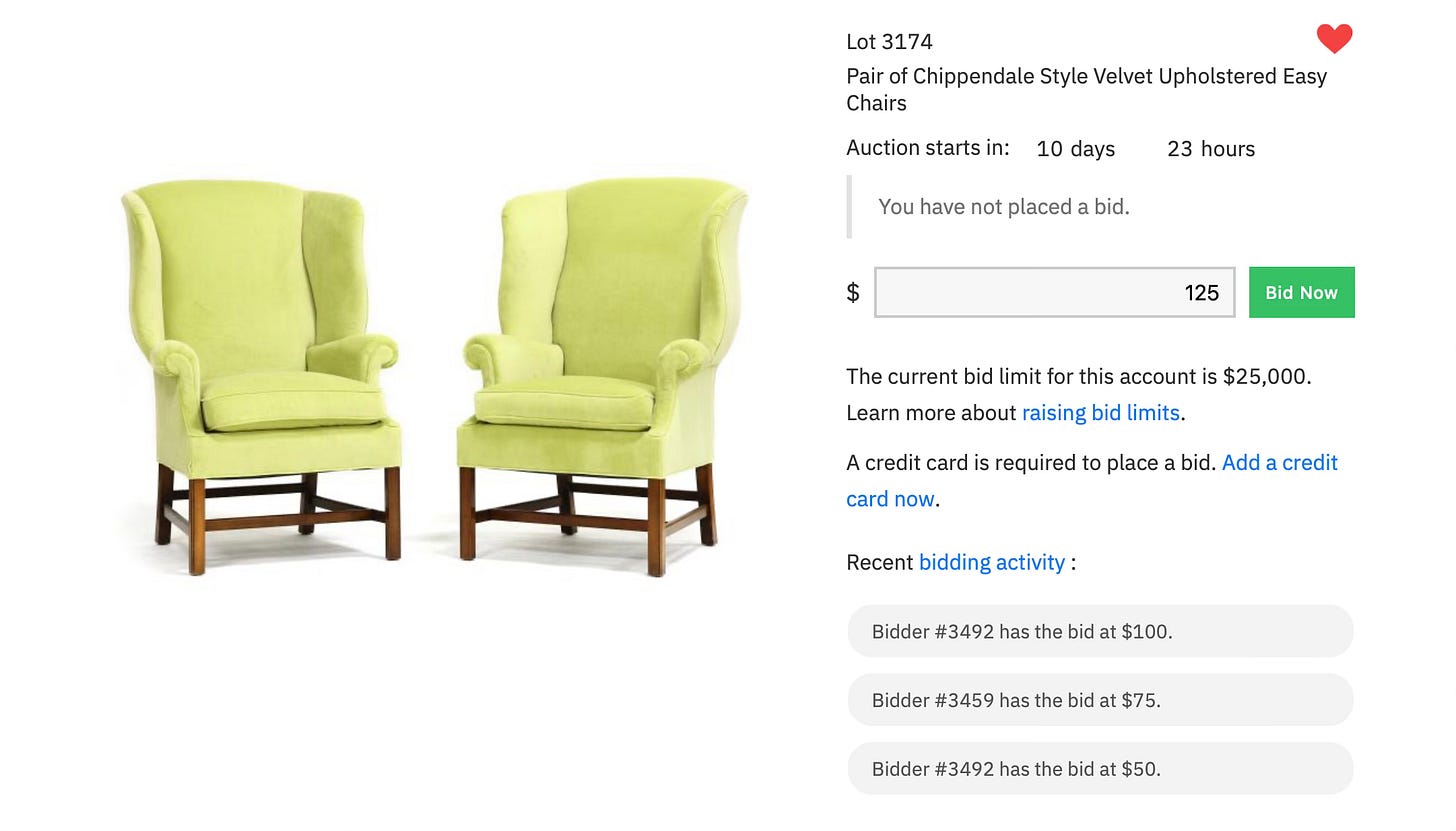Auction Finds: A malachite coffee table, neon wing chairs, and a portrait miniature with attitude
Plus, an elegant woodblock print, a tiny tea set, and my thoughts on 'brown' furniture: spoiler alert, it's hot!
Welcome to Auction Finds, a subscriber-only behind-the-scenes look at an upcoming auction, delivered in time for you to act if something catches your eye. Every piece is currently available for bidding at the time of posting.
As a design historian, I've always been drawn to auctions - they offer glimpses of pieces rarely seen elsewhere, often hidden in private collections for decades. These auction finds are more than just objects—they're windows into history, craftsmanship, and the stories that fascinate me about design. Whether you're an experienced collector or just curious about the world of auctions, join me in a deep dive into these finds:
This is the beginning of the content for paid subscribers (you!!). All pieces featured today are from Leland Little's February 13th auction (9 a.m. start). This excellent house is known for museum-quality pieces; its prices reflect that quality. Don't worry—in future weeks, I'll share some of my favorite sources for more accessible finds! Okay, let's dive in!
Art Deco Style Faux Malachite Cocktail Table I've found coffee tables to be one of the trickier pieces of furniture to reliably find - and this is a great piece! What works here is the clean architectural form with stepped or waterfall-style sides that create a symmetric, tiered effect. The glossy finish and minimalist design are hallmarks of both Art Deco and Hollywood Regency styles, making this piece a sophisticated statement. And you know I love a malachite object!
Portrait Miniature of a Regency Dame I cannot stop looking at this Regency-era portrait miniature - our lady here is giving what my teenager would call 'major attitude.' She's dressed in all the right fashions of the day - red Empire waist gown cut daringly low, trendy white turban with fancy trim - but her expression steals the show. While most miniatures from this period depict their subjects in flattering, idealized poses, this woman seems to be giving the artist (and perhaps her lover who commissioned it) a piece of her mind! There's something wonderfully modern about her skeptical gaze and slightly raised chin as if she's about to deliver a cutting remark worthy of Jane Austen. The artist knew their craft - the delicate brushwork and subtle shading are what you'd hope to find in a miniature. But it's the personality that makes this piece unique. Set in a lovely pendant frame, it's the kind of portrait that makes you wonder about the story behind it. Who was she? And what was she thinking as she sat for this tiny masterpiece of side-eye?
A Chinese Woodblock Print of a Lotus Plant: I love how these coral-pink lotus blooms emerge from those deep charcoal-gray leaves. The artist’s use of negative space is sophisticated and confident.
A Set of Eight Chinese Porcelain Tea Bowls I'm charmed by these tiny tea bowls - each one barely bigger than my palm at 2.5 inches across. The decoration alternates between two patterns: a dramatic phoenix with flowing tail feathers and what looks like a delicate pagoda scene. Similar to the print above, what really gets me is how the artist used white space - a perfect balance between decorated and undecorated areas. Finding all eight pieces together is pretty unique - they were clearly made as a set for formal tea service and somehow managed to stay together all these years. Depending on the condition and price, this size bowl would be lovely to force a few paperwhite bulbs or a single hyacinth bulb.
Pair of Chippendale Style Velvet Upholstered Easy Chairs: The neon fabric caught my eye — it's bold and modern, and the form is classic Chippendale. I'm such a sucker for those distinctive 'wings' that extend from the back of the chair. They were initially designed to shield the sitter from drafts or protect them from the heat of a fireplace. I love this elegant practicality in design - form and function in harmony! The traditional elements are all here - rolled arms, straight wooden legs with stretchers - but the unexpected color makes these chairs sing. They're the kind of pieces that could anchor a formal living room or add gravitas to a contemporary space. And since they're a pair (which isn't always easy to find), you have more flexibility in using them - flanking a fireplace, creating a conversation area, or even splitting them up for maximum impact in different rooms.
George III Inlaid Mahogany Chest of Drawers: For the last few decades, this lovely piece would be written off as 'brown furniture.’ As someone who has spent too much time in museum storage rooms and auction previews, I have Thoughts (yes, with a capital T) about this dismissive term. Sure, it's brown, but calling it 'brown furniture' is like calling the Met's Temple of Dendur' that old stone structure.' The craftsmanship here is extraordinary - look at the inlay work on the top of the dresser! And those bracket feet give it such an elegant lift, like a dancer en pointe. I've noticed more young collectors getting excited about these pieces, and it makes total sense. This is beautifully made furniture, often from mahogany, that has already survived 200+ years (talk about sustainability!). And there's something deeply satisfying about mixing a Georgian chest like this into a modern room - it adds instant soul and history.
What does the term ‘George III’ even mean?
A quick design history note, because I can't help myself and I think the term "George III" is a little "inside baseball" - The term refers to the fact that this piece was made during the reign of King George III (1760-1820) when English furniture-making was having a moment. Think of it as the equivalent of the American mid-century modern heyday - in England during this time, artisans like Chippendale and Sheraton created objects that would influence furniture design for centuries. The emphasis was all about perfect proportions, quality materials, and those refined details that make my design historian heart skip a beat.
A Final Word for Fellow Design Obsessives
For those just dipping their toes into the auction world and even those of you who are old hands, remember: collecting is a journey, not a destination. Each piece you encounter tells a story, whether it becomes yours or simply passes through your imagination. Start small, ask questions, and let your curiosity guide you. With online auctions, I've found it best to set my highest bid beforehand and then go for a long walk during the auction. It's very easy to spend more than you want or than an object is worth in the heat of the moment (ask me how I know 😂).
Next month, I'll be back with another subscriber-only auction preview because great design is everywhere. Until then, here's to keeping our eyes open and our sense of wonder intact. P.S. Hit that reply button and tell me which piece spoke to you most. I'm always eager to hear your stories and perspectives!
An Experiment for Subscribers-Only
I've created a Google Calendar just for subscribers - once you add the calendar you should be able to add a reminder about this auction starting to your personal calendar. This is an experiment—if something about the calendar doesn't work for you, please let me know so I can refine it!
A Quick and Dirty Auctions 101
If any of these pieces have caught your eye, now's the time to do your homework. If you haven't already, you'll need to create an account with Leland Little and be verified to bid (typically, this is just providing a credit card). Then, request those condition reports, calculate your total budget (don't forget those buyer's premiums!), and most importantly - have fun with it.
About object condition: While I've looked carefully at the online photos, I always recommend requesting a detailed condition report from the auction house before bidding. Leland Little's specialists are thorough and responsive - you can request reports directly through their website for any lot that interests you.
About buyer's premiums: Remember to factor in the auction house fee! At Leland Little, you'll pay an additional 20% if you bid through their website or 25% if you use a third-party platform. When deciding my maximum bid, I always include this in my mental math—these premiums can add up!
Shipping antiques can be complex and expensive. It often requires you to source a shipper with whom you'll need to communicate beforehand and pay separately. Of course, you'll need to factor these costs into your budget (or plan to pick up your win in person if you're local).
If you're new to auctions, I suggest starting small — maybe bid on a portrait miniature or those tea bowls rather than a mahogany chest! The whole process has a learning curve, from requesting condition reports to understanding buyer's premiums to arranging shipping. Think of it like learning to swim—start in the shallow end before diving into the deep end with larger pieces.













As an architectural historian who loves antiques and all things green (including all manner of green objects), I have found my substack soulmate. Thank you, Abbey!